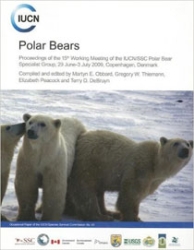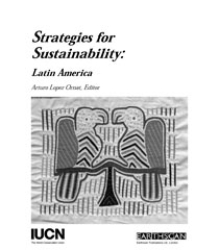World Conservation Union
Landscape Conservation Law
Present Trends and Perspectives in International and Comparative Law
The attention given to landscape in environmental law is new and the subject raises a series of interesting problems, which were highlighted at a Colloquium. Its central theme was the draft European Landscape Convention prepared by the Council of Europe, the first of its kind. Since 1998, the draft has evolved, and has reached its almost final form; it is expected to be adopted during 2000. In addition to considering the draft Convention, the Colloquium also explored the elements of landscape conservation law in various parts of the world.
Polar Bears
Proceedings of the 14th Working Meeting of the IUCN/SSC Polar Bear Specialist Group, 20-24 June 2005, Seattle, Washington, USA
These proceedings provide an overview of the ongoing research and management activities on polar bears in the circumpolar arctic. Together with the previous 13 proceedings, they provide an historic record of international efforts in protecting, studying and managing polar bears.
Guidelines for Applying Protected Area Managment Categories
IUCN’s Protected Areas Management Categories, which classify protected areas according to their management objectives, are today accepted as the benchmark for defining, recording, and classifying protected areas. They are recognized by international bodies such as the United Nations as well as many national governments. As a result, they are increasingly being incorporated into government legislation. These guidelines provide as much clarity as possible regarding the meaning and application of the Categories.
Adrift
Tales of Ocean Fragility
This book is a product of the Marine Conservation Sub-Committee, an advisory body on marine species issues within IUCN. The book features twelve stories of different ocean animals that highlight the latest issues in marine conservation. The tales in this exquisitely illustrated book are testament to not only the eccentricity of life in our oceans, but also the diversity of challenges and opportunities we face to conserve these marine marvels.
Dryland Opportunities
Drylands cover 41 percent of the earth’s terrestrial surface. The urgency of and international response to climate change have given a new place to drylands in terms both of their vulnerability to predicted climate change impacts and their potential contribution to climate change mitigation. This book aims to apply the new scientific insights on complex dryland systems to practical options for development.
Strategies for sustainability
Latin America
A series of regional reviews of multi-sectoral strategies for sustainability at the national, provincial, and local levels, complementing the volume on "Strategies for national sustainable development". This volume summarizes the status of strategies in the region, reviews and analyses case studies to provide an analytical history and status report on each strategy. The information has hitherto not been available, and will be very valuable for practitioners and policy makers, as well as for students of development.
Management Guidelines for IUCN Category V Protected Areas
Protected Areas Protected Landscapes / Seascapes,
Protected Landscapes (IUCN Protected Area Category V) are lived-in working landscapes. In the past, there has been a tendency to see them as a rather Eurocentric approach to protected areas but increasingly the category is being designated in other parts of the world, including in a number of developing countries. The Guidelines include sections on the background and on the planning of such areas, and chapters on the principles, policies, process and the means for their management.
North American Rodents
Status Survey and Conservation Action Plan
The first comprehensive treatment of North American rodents of conservation concern. This action plan summarizes the rodent fauna of North America and provides available information on every rodent taxon that has been considered to be of conservation concern by state, provincial and private conservation agencies and regional experts. It is hoped that the survey provided in this action plan will serve as a common ground for all these parties in drawing up conservation strategies for rodents.
Guidelines for Cave and Karst Protection
Cave and karst landforms are distributed widely around the world. They have many values and are an integral component of the world's biodiversity. Some are habitats for a wide range of endemic species of flora and fauna, while others house rare and endangered species. Still others are the sources of rare minerals and some are important for resources such as groundwater, while some are venerated as sites of religious, spiritual and cultural importance. Many such landforms encompass one or many of these values. As special places, cave and karst landforms require special management.










